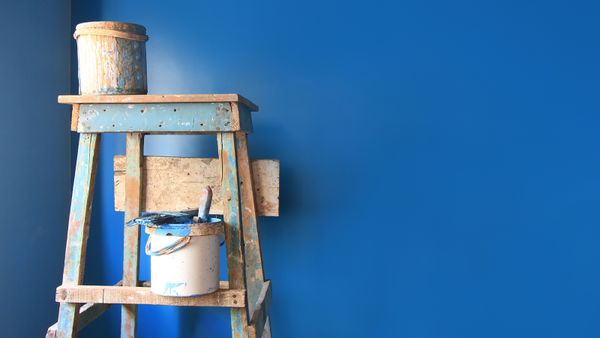Painting is an inexpensive way to update a room with a great amount of impact. If you want to add a little drama, but only have time for a quick weekend project, you might consider painting an accent wall. Unless you're a decorator by trade, you probably painted each room all the same color. If you even ventured into the world of color on your walls, that is. Painting one wall a different shade of the room's color, or even a different color entirely, will add some visual interest to a space that could use a little perking up.
Choose Your Wall
Advertisement
Before you get started, you need to pick the wall you want to paint. Start by taking a look around the room. Is there a place your eyes are naturally drawn to when you walk in? If so, this is your focal point. It may not be a feature you want to show off, so it's up to you to designate the focal point by choosing to highlight a wall that has architectural details, like a fireplace or a built-in bookshelf.
In your bedroom, the wall with your headboard is a good choice. Perhaps you have a collection of paintings or accessories that you want to highlight, so you can paint the wall where they're displayed. An accent wall can also help make an awkward room seem less so. If you have a long, narrow room, painting the short wall at the far end will make it seem closer and less oblong.
Choose Your Paint
One way to paint an accent wall is to choose a color a couple of shades darker than the other walls. There are seven colors in the paint spectrum, but most paints are made up of multiple colors. For example, blue isn't just blue -- it usually has gray or green or yellow or red in it, which can make finding the right complement to the blue on your walls a real bear. You can find paint chips with a range of three to six shades in the same color family. This is a failsafe way to make sure you choose the right shade of gray-blue in a darker tone to complement your light gray-blue. If you really want to pack a punch, you can also choose a different, but complementary color all together.
Recall your early art classes and choose from colors opposite each other on the color wheel for the ultimate dramatic statement. But here's a quick tip: Take advantage of the sample sizes of paint that most home improvement stores offer, and try a small swatch on the wall you want to paint. Paint colors look different depending on the light, so that lovely sage green could turn out to look more like seafoam.
If you feel like getting a little crafty, you can step into the world of DIY faux finishes. Just be sure to experiment on a smaller surface first. Or skip the paint altogether and try out a wall covering. Wallpaper has made a big comeback, so you can choose from a variety of bright patterns or natural materials with mellow textures. Whatever you choose, make it stand out from the rest of the walls.
Advertisement

